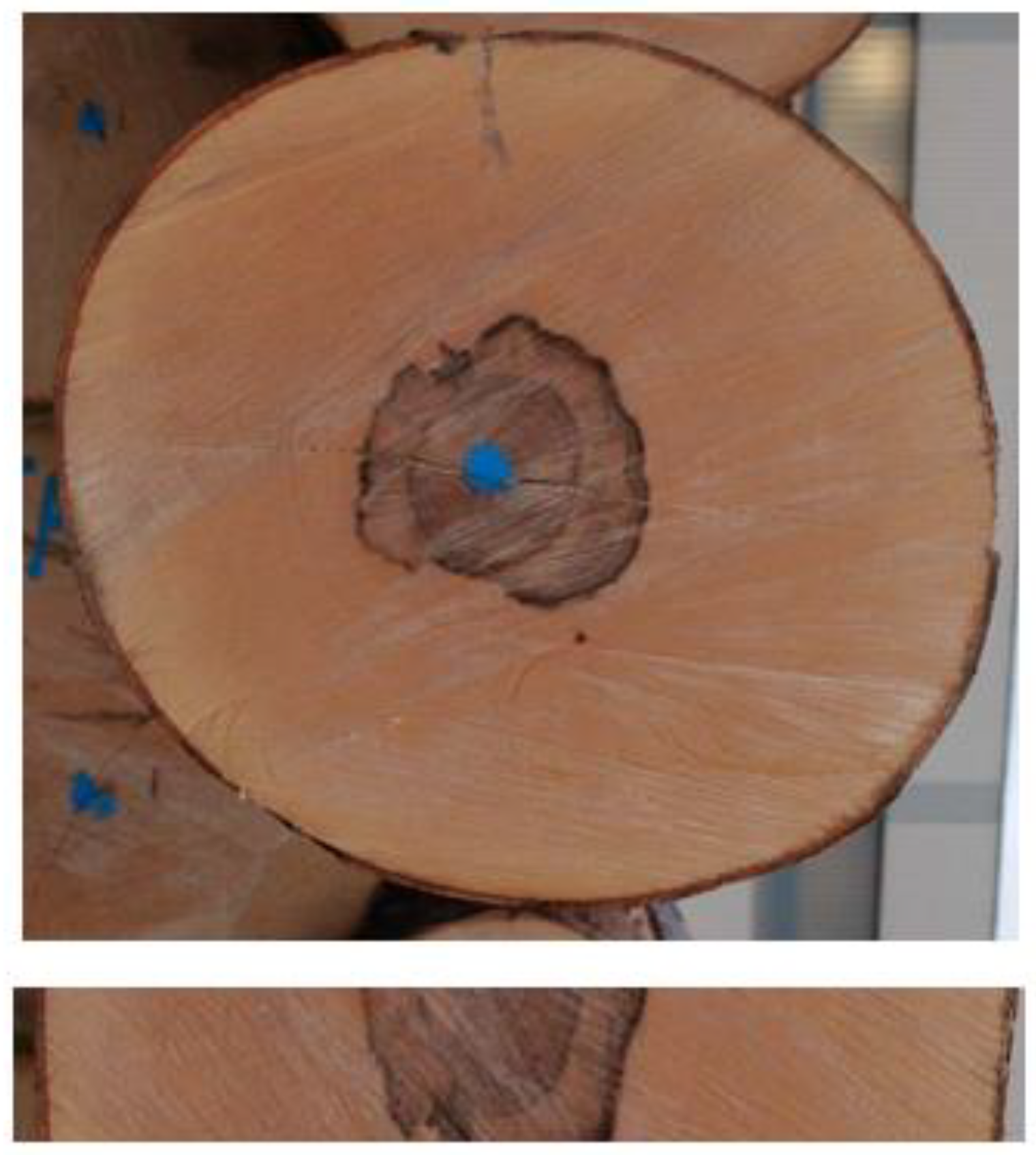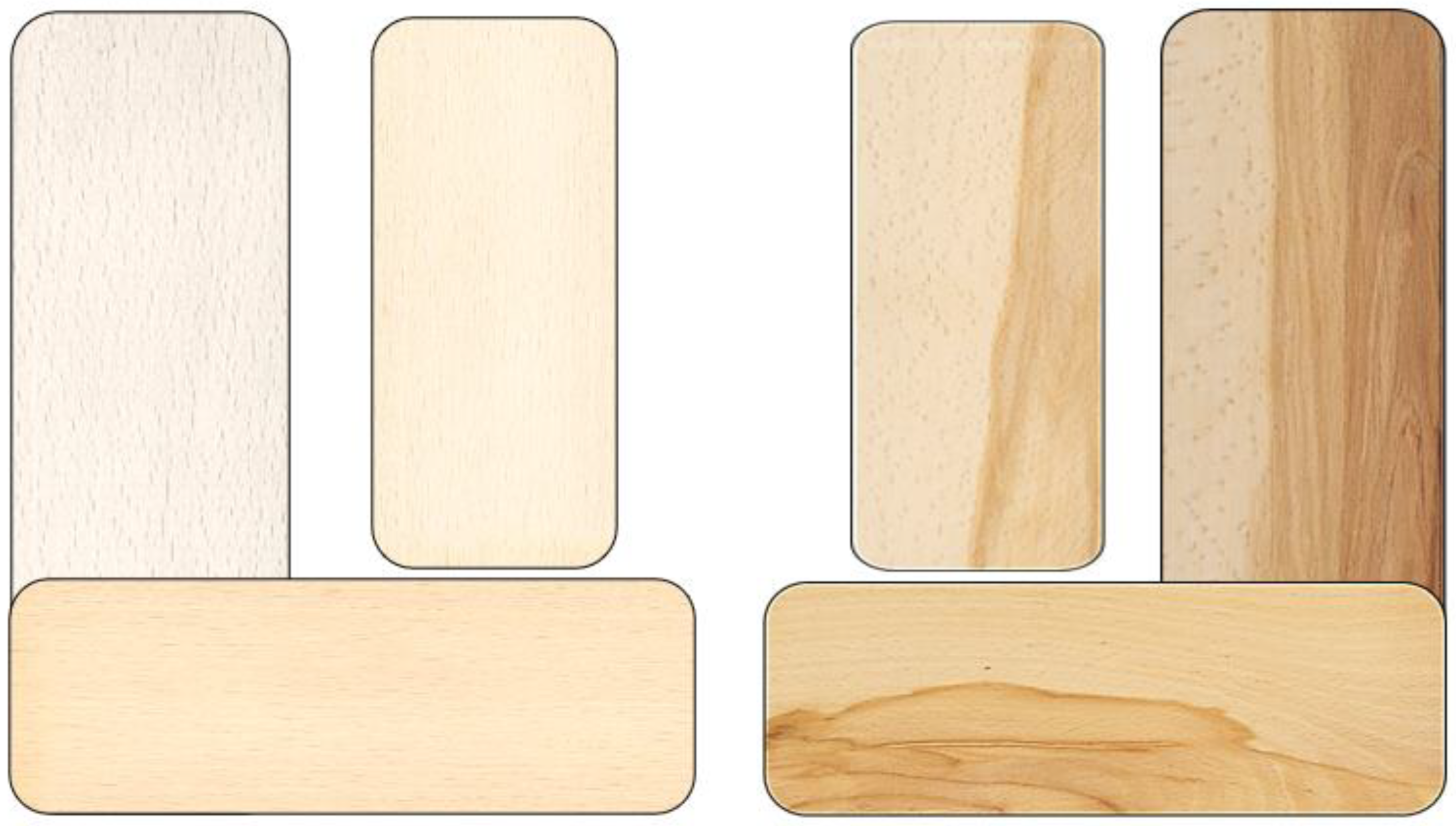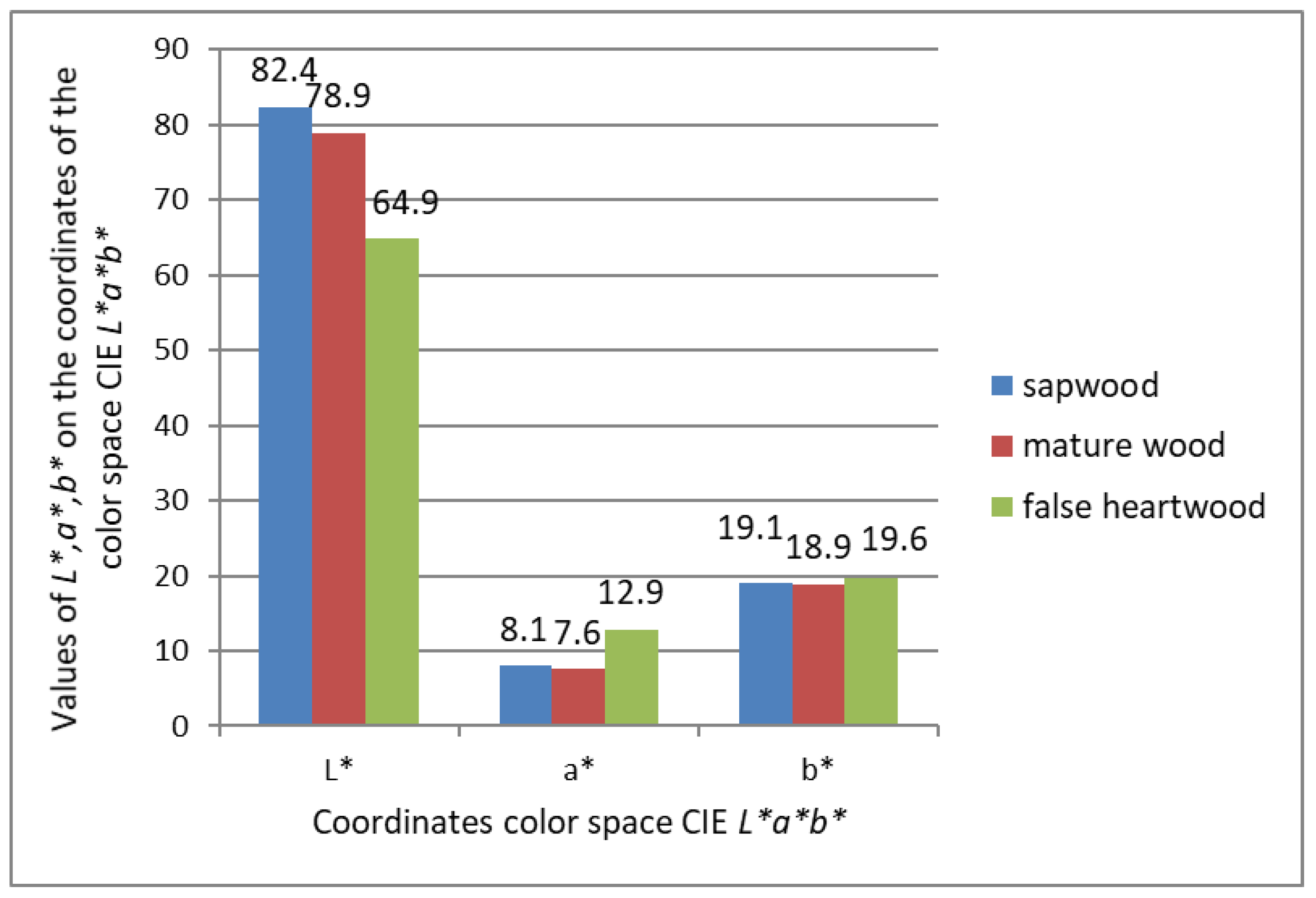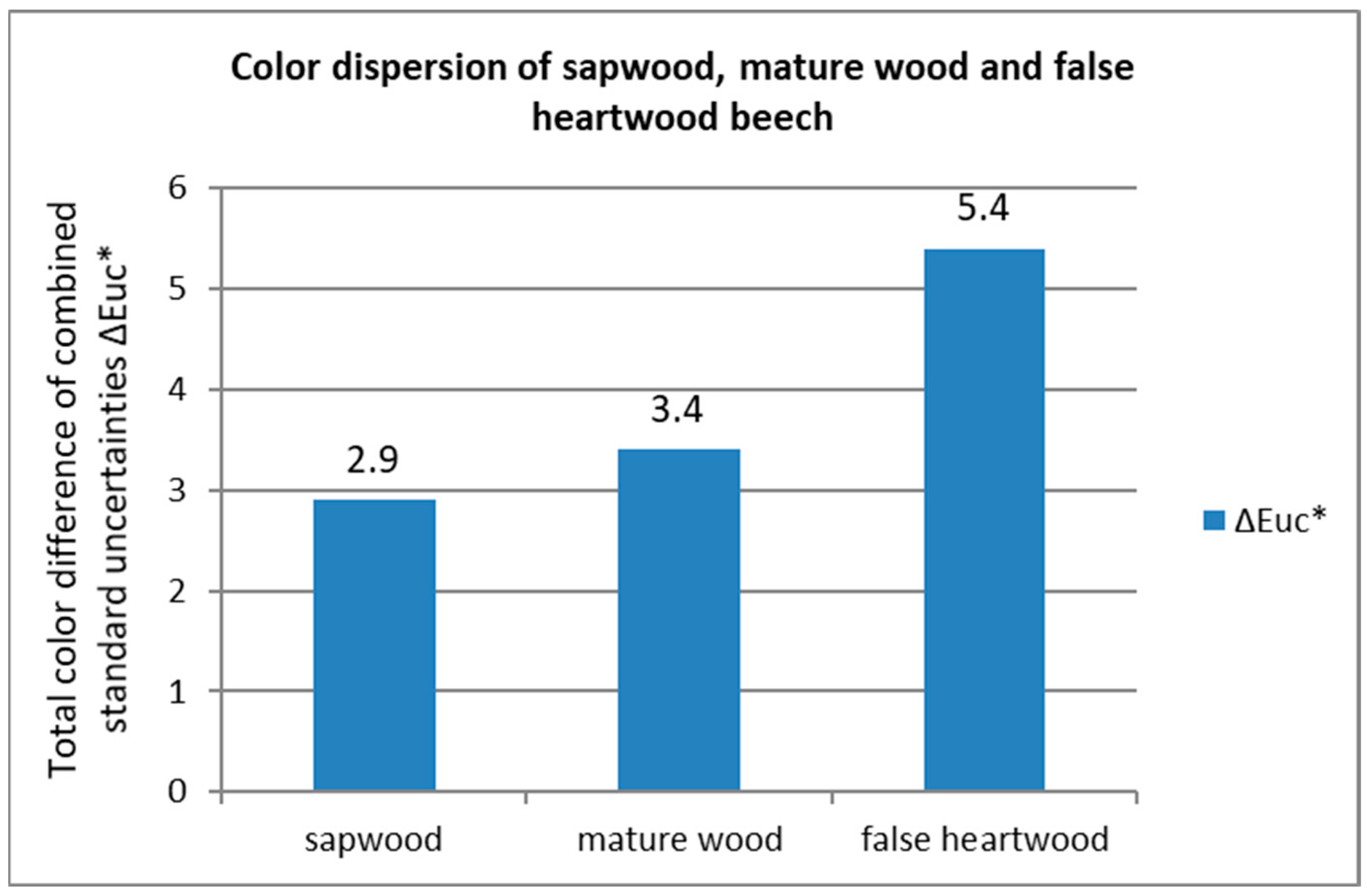1. Introduction
The color of wood is a basic physical-optical property that belongs to the group of macroscopic features on the basis of which the woods of individual trees differs from one another in appearance. The color of wood is created by chromophores, i.e., functional groups of the type: >C=O, -CH=CH-CH=CH-, -CH=CH-, aromatic nuclei found in the chemical components of wood (lignin and extractive substances, such as dyes, tannins, resins), which absorb electromagnetic radiation in the UV-VIS area of daylight radiation.
Reflected electromagnetic radiation from the surface of a monitored object entering the human eye creates a psychophysiological sensation in the human mind, which is manifested by the perception of the color of the observed object.
Beech wood belongs to scattered-porous, coreless woods that are capable of forming a false heartwood. The natural color of dried beech sapwood and mature beech wood is described in the professional literature as ocher white, white with a reddish tint, skin-pink, or light gray with a yellow or red tinge.
In older trees, there may be red-brown wood in the middle of the trunk, the so-called false heartwood. A false heartwood beech is a growth defect that arises from the oxidation of soluble carbohydrates and starches in the mature wood zone by atmospheric oxygen [
1,
2]. According to the appearance of false heartwood in tree trunks and its shape on the cross-section of trunks, false heartwood is divided into types: round, star mosaic, and flame (eccentric, centric) [
3]. According to the literature, the color of the false heartwood of healthy round beech wood is red-brown.
Due to the effect of heat changes in the process of drying or steaming the wood, beech wood acquires a pale pink, pink-red to dark brown-red shade [
4,
5,
6,
7,
8,
9]. To evaluate the degree of wood color change in wood-drying processes, the authors [
10] proposed a classification of the effect of drying on wood color change through the total color difference ∆
E* in the range of values from 0.2 to 12. Similarly, for steamed wood, a verified scale of the change of the total color difference ∆
E* at the temperature of saturated water steam and the length of the steaming time in the value interval of 2 to 24 was proposed [
11].
The color of wood also changes due to UV radiation or long-term exposure to sunlight on its surface. The surface of the wood darkens and mostly turns brown. This fact is also referred to in the professional literature as natural aging [
12,
13,
14,
15,
16].
One of the ways to objectively identify a given optical property of wood is to express the wood color through coordinates: lightness L*, red color a* and yellow color b* on chromatic coordinates in the color space CIE L*a*b*. According to the work [
17], coreless wood (sapwood and mature wood) of
Fagus sylvatica L., in the color space CIE L*a*b*, is described by the values on the color space coordinates L* = 75.96; a* = 6.62; b* = 17.63. In the work [
18], the following values are provided for the color of beech wood: L* = 75.4; a* = 10.1; b* = 23.7. The authors [
19] describe the color of native beech wood before treatment with UV radiation in the form of a notation, i.e., the average value and combined standard uncertainty of measurement for white wood, by the values: L* = 76.6 ± 2.3; a* = 6.9 ± 1.3; b* = 19.8 ± 1.7.
Based on extensive experimental research on the color of beech wood, the aim of this work is to determine the color on the tangential surface of the planed surface of dry wood from the zone, sapwood, mature wood and false heartwood in the color space CIE L*a*b and to determine the natural color variability of sapwood, mature wood and false heartwood of Fagus sylvatica L., from trees with a false heartwood. By defining the boundaries of the color of sapwood beech blanks, mature wood and the color of the wood of the false heartwood in the color space, space is created both for sorting beech wood according to the customer’s requirements for wood color and also for designers when applying beech wood to create color compositions that depend on darkness and color shades.
2. Material and Methods
The wood color was measured on beech wood of
Fagus sylvatica L. from Male Karpaty, Poľana, and Vihorlat, locations in the Western Carpathian Mountains located in Slovakia. From each site, 25 lumber-logs with round false heartwood were selected. The wood with false heartwood was not attacked by fungal hyphae or damaged by rot. They were made into lumber by sharp cutting. Blanks with dimensions of 24 × 38 × 500 mm
3 were made from the central lumber with a thickness of h = 38 mm (
Figure 1). Three pieces of blanks were randomly selected from the zone of sapwood, mature wood and false heartwood from each central lumber. The blanks were dried in an air-conditioned room at a temperature of t = 20 °C and a relative humidity of φ = 60% to a moisture content of w = 10 ± 0.5%. The mentioned drying method was chosen in order to exclude the effect of heat on changes in the color of the wood. The bedding surfaces of dry blanks from sapwood, mature wood and false heartwood were machined on a horizontal-plane milling machine FS 200. The surface roughness of the surface of the planed blanks was Ra = 1.6–6.3 μm.
The color of the wood of the beech blanks in the color space CIE L*a*b* was measured with a Color reader CR-10 colorimeter (Konica Minolta, Osaka, Japan). A D65 light source was used, and the diameter of the optical sensing aperture was 8 mm.
The color space CIE L*a*b* is defined by a color model based on the measurement of three parameters: the lightness L* with values from 100 for white to 0 for black, the chromatic coordinate a* for determining colors between red (+a) and green (−a), and the chromatic coordinate b* for determining the color between yellow (+b) and blue (−b).
The measurement of the lightness values L*, basic chromatic coordinates of red color a* and yellow color b* of the color space CIE L*a*b* and chroma C* of sapwood, mature wood and false heartwood was performed on the planed surface of dry blanks. The measured values are provided in the form of the notation i.e., the average measured value and the combined standard uncertainty of the measurement.
The average values
are calculated from the measured values L*
i, a*
i, b*
i, and chroma C*
i according to the equations:
where L*
i, a*
i, b*
i—measured values of the coordinates of the color space CIE L*a*b* and chroma C*
i; and n—number of measurements.
The combined standard uncertainty u
c expressing the dispersion of values for the measured quantity takes into account type A and type B uncertainties.
where u
A—standard uncertainty of type A; and u
B—standard uncertainty of type B.
The calculation of the combined standard uncertainty u
c for values of individual coordinates of the color space CIE
L*a*b* and chroma u
Cc are provided by the equations:
where L*
i, a*
i, b*
i—measured values of the coordinates of the color space CIE L*a*b*; C*
i—measured chroma values in the color space CIE L*a*b*;
,
—average values of sets of measured values in the color space CIE L*a*b*;
—average value of a set of measured chroma values on color space coordinates; n—number of measurements; and u
BL*, u
Ba*, u
Bb*, u
BC* = 0.1 standard deviations of the Color reader CR-10 device from the nominal value.
The values of the relative standard deviation of
relu
ci expressing agreement with the repeatability of measurements of individual values on the coordinates of the color space and chroma
relu
cc are described by the equations:
where u
Ci—combined standard uncertainties on the respective color space coordinates; u
cC—combined standard uncertainty of chroma; and
,
—average values of sets of measured values in the color space.
The color dispersion of beech sapwood, mature wood and false heartwood in the color space CIE L*a*b*, determined through the values of the combined standard uncertainties resulting from the measurements, is quantified by the modified equation of the total color difference:
where
—combined standard value of lightness measurement uncertainty u
cL*;
—combined standard value of measurement uncertainty of red color u
ca*; and
—combined standard value of yellow color measurement uncertainty u
cb*.
The visual difference between the color of beech sapwood and the false heartwood, whether between the color of sapwood and mature wood or between the color of sapwood and the color of mature beech wood, is numerically quantified by the values determined through the equation of the total color difference ΔE*:
where
,
,
i—average values of the coordinates of the lightness, red and yellow color of sapwood; and
,
,
average values of the coordinates of the lightness, red and yellow color of the false heartwood or mature beech wood.
3. Results and Discussion
Figure 2 shows the color and color shades of the analyzed samples of dry beech sapwood, mature wood and false heartwood. The results of the statistical processing of the measured color values of beech wood samples for the individual coordinates of the color space CIE
L*a*b* and chroma
C* are presented in
Table 1,
Table 2 and
Table 3.
The color differences between beech sapwood, mature wood and false heartwood in the coordinates of the color space CIE L*a*b* are presented in the bar diagram in
Figure 3.
The dispersion of the values of the colors of sapwood, mature wood and false heartwood in the coordinates of the color space CIE L*a*b* expressed through the total color difference ∆Euc* is shown in
Figure 4.
The color of the analyzed sapwood samples shows shades ranging from light white-gray-yellow to pale pink. In the color space CIE L*a*b*, it is described by the values of the lightness coordinate L* = 82.4 ± 1.9, red color a* = 8.1 ± 1.5 and yellow color b* = 19.1 ± 1.6. The color of the wood is white compared to the color of mature wood and false heartwood, as shown in
Figure 1. Additionally, the values in
Table 1,
Table 2 and
Table 3 are the lightest. The color dispersion of sapwood expressed by the total color difference is ∆Eu
c* = 2.9. The value of the combined standard deviation, red color u
ca* = 18.5%, has the greatest influence on the color dispersion of the sapwood color dispersion. The statement about the influence of red color on the dispersion of the color of coreless beech wood is in accordance with the opinions of other authors, who declare this fact, while showing higher values of the coefficients of variation of red color. In the works of [
20,
21], the values of the coefficient of variation of red color are on the level of v
x−a* = 22.8% and v
x−a* = 23.22%.
Mature beech wood is slightly darker than sapwood. The average color values of the coordinates of the color space CIE L*a*b* coincide with the values of the lightness coordinate L*, as well as the chromatic coordinates of red color a* and yellow color b*, for beech wood given in the literature [
17,
18,
19]. The slight increase in the darkness of mature beech wood is attributed to the increased proportion of lignin in the cell walls.
The degree of difference between the color of mature beech wood and the color of sapwood is quantified by the value of the total color difference ∆E* = 3.4. According to the categorization of the size of the color changes, the indicated value characterizes the color difference of mature wood as a visible color change. It is caused by a decrease in the average lightness value by ∆L* = −3.5 and a decrease in the values of the chromatic coordinates: red color by ∆a* = −0.5 and yellow color by ∆b* = −0.2. The color saturation of mature beech wood, compared to the color saturation of sapwood, is lower by ∆C* = −0.3. The color dispersion of mature beech wood from the light white-grey color of sapwood in the CIE L*a*b* color space is caused by the red color a*, whose combined standard deviation value is uca = 22.3%.
The color of the wood of false heartwood is identified in the color space CIE L*a*b* by the average lightness value L* = 64.9 ± 4.9 and the average values on the chromatic coordinates red color a* = 12.9 ± 2.1 and yellow color b* = 19.6 ± 1.7. The visual difference between the color of wood with false heartwood and the color of sapwood is numerically documented by the total color difference ∆E* = 18.1. In the categorization of the size of color differences between colors, the stated value is among very significant color changes.
A wide range of shades ranging from pale brown-yellow to brown-red-gray is characteristic of the color of the wood of false heartwood. It is expressed numerically by the values of the combined standard uncertainties of the coordinates of lightness uCL* = 4.9, red color uCa* = 2.1, yellow color ∆uCb* = 1.7 and color dispersion ∆EuC* = 5.4. The color variance of the false heartwood is almost twice as high as the color variance of the sapwood.
The change in the color of the wood of false heartwood and the dispersion of its color is caused by an increased number of chromophores in polyphenolic compounds created by the oxidation processes of soluble carbohydrates and starch contained in the lumens of parenchymal cells, depending on the length of time of formation of the false heartwood. Changes in the chromophoric system of the wood of the false heartwood, in contrast to the chromophoric system of the sapwood and mature beech wood, are manifested in a lower degree of absorption of electromagnetic radiation of wavelengths ranging from 570 to 750 nm, i.e., red, orange and yellow colors. The reflected electromagnetic radiation of the mentioned wavelengths from the surface of the wood of the false heartwood creates a variety of brown color shades perceived by the human eye.
Based on the measurements of the color of dry beech wood, dried by low-temperature wood-drying technologies without affecting the wood’s color change [
10,
11], it is possible to state that in the trunk of a beech trunk with a circular false heartwood, wood with three colors is found. In addition to the significantly darker red-brown or brown-yellow color of the false heartwood in the center of the trunk, there is light white-gray-yellow sapwood in the peripheral part of the trunk, and the rest of the coreless material has a light ocher-white color. A large dispersion of color shades of sapwood and mature beech wood can create the impression in the lay public of a uniform color of the coreless mass of beech wood.
The presented values of the natural color of dry beech sapwood, mature wood and false heartwood in the coordinates of the CIE L*a*b* color space are a source of information for determining the color of beech wood dried by low temperature or purposefully modified convection hot air modes preventing the formation of new chromophores in the wood during drying. In case of customer request, they can be used to classify beech wood into color classes.
Defining the color of wood through coordinates in the color space CIE L*a*b* creates space for designers to model the color compositions of beech wood by computer, depending on the darkness and color shades of the beech wood.
4. Conclusions
The article presents the color values of dry beech wood, sapwood, mature wood and false heartwood in the color space CIE L*a*b*. Sapwood has a color ranging from light white-gray to pale pink. In the color space CIE L*a*b*, it is identified by the values of the lightness coordinate L* = 82.4 ± 1.9 and the chromatic coordinates of red color a* = 8.1 ± 1.5 and yellow color b* = 19.1 ± 1.6. Compared to the color of mature wood and false heartwood, it is the lightest and most homogeneous in color.
Mature wood is slightly darker in color compared to sapwood, with average values of L* = 78.9 ± 2.4, a* = 7.6 ± 1.7 and b* = 18.9 ± 1.9. With a value of ∆EuC* = 3.4, the color variance of dry mature beech wood is 15% greater than the color variance of sapwood.
The color of the wood of false heartwood is in a range spanning from brown-yellow to red-brown. The specified color is described in the coordinates of the color space CIE L*a*b* by the following values: L* = 64.9 ± 4.9, a* = 12.9 ± 2.1 and b* = 19.6 ± 1.7. The dispersion of the color of the wood of the false heartwood is ∆EuC = 5.4. The difference in the colors of the wood of the false heartwood, as well as the wide dispersion of colors, is dependent on the length of time of the modification of the chromophore system of wood by the processes of oxidation of soluble carbohydrates and starch contained in the lumens of parenchymal cells during the formation of the false core in a growing tree.
The visual color differences between sapwood and mature beech wood and between sapwood and false heartwood numerically express the values of the total color differences ∆E* = 3.5 and ∆E* = 18.1. Within the framework of the categorization, the difference between the color of mature wood and the color of sapwood belongs to the category of visible changes, and the difference between the color of the wood of a false heartwood beech and the color of sapwood belongs to the category of significant color changes.









